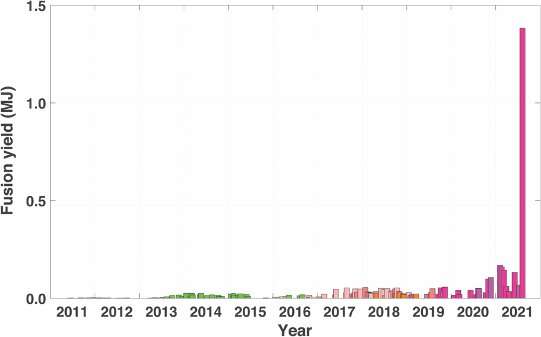The fusion yield (megajoules) from 2011 to present. Credit: LLNL
After decades of inertial confinement fusion research, a record yield of more than 1.3 megajoules (MJ) from fusion reactions was achieved in the laboratory for the first time during an experiment at Lawrence Livermore National Laboratory's (LLNL) National Ignition Facility (NIF) on Aug. 8, 2021. These results mark an 8-fold improvement over experiments conducted in spring 2021 and a 25-fold increase over NIF's 2018 record yield (Figure 1).
NIF precisely guides, amplifies, reflects, and focuses 192 powerful laser beams into a target about the size of a pencil eraser in a few billionths of a second. NIF generates temperatures in the target of more than 180 million F and pressures of more than 100 billion Earth atmospheres. Those extreme conditions cause hydrogen atoms in the target to fuse and release energy in a controlled thermonuclear reaction.
LLNL physicist Debbie Callahan will discuss this achievement during a plenary session at the 63rd Annual Meeting of the APS Division of Plasma Physics. While there has been significant media coverage of this achievement, this talk will represent the first opportunity to address these results and the path forward in a scientific conference setting.
Achieving these large yields has been a long-standing goal for inertial confinement fusion research and puts researchers at the threshold of fusion ignition, an important goal of NIF, the world's largest and most energetic laser.
The fusion research community uses many technical definitions for ignition, but the National Academy of Science adopted the definition of "gain greater than unity" in a 1997 review of NIF, meaning fusion yield greater than laser energy delivered. This experiment produced fusion yield of roughly two-thirds of the laser energy that was delivered, tantalizingly close to that goal.
The experiment built on several advances developed over the last several years by the NIF team including new diagnostics; target fabrication improvements in the capsule shell, fill tube and hohlraum (a gold cylinder that holds the target capsule); improved laser precision; and design changes to increase the energy coupled to the implosion and the compression of the implosion.
These advances open access to a new experimental regime, with new avenues for research and the opportunity to benchmark modeling used to understand the proximity to ignition.
More information: Abstract: AR01.00001. Achieving a Burning Plasma on the National Ignition Facility (NIF) Laser
Provided by American Physical Society
























